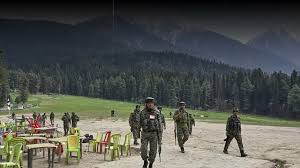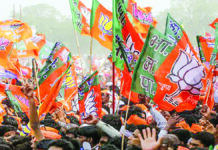Tahawwur Rana’s looming extradition deepens Gen Munir’s vulnerability, risking exposure of Pakistan military’s terror links.
NEW DELHI: Like Hamas leaders before their October 7 2023, assault on Israel, General Asim Munir, the Chief of the Pakistan Army, deliberately fanned sectarian flames to galvanise extremist factions just days ahead of the Pahalgam terror attack.
Gen Munir stood before a crowd at the Overseas Pakistanis Convention (OPC) in Islamabad and invoked the contentious ‘Two-Nation Theory’, branding Kashmir Pakistan’s “jugular vein.” His speech was a call to arms.
The inflammatory speech, Gen Munir’s desperate bid for political survival, reignited historical animosities.
Pakistan’s internal landscape was combustible: escalating violence from the Tehreek-e-Taliban Pakistan (TTP), rising insurgencies in Balochistan, and lingering political instability amid the jailing of former Prime Minister Imran Khan had dramatically weakened Gen Munir’s grip on power, a Pakistani analyst on the condition of anonymity, observed, “Generals are silently conspiring against Munir; he needed Kashmir as a diversion.”
Hamas, being called out for its mismanagement in Gaza, had similarly needed a rallying point among people to ensure it had public sentiment on its side, at least.
The looming extradition of Tahawwur Rana, facilitator of the 26/11 Mumbai attacks, compounded Gen Munir’s vulnerability, threatening to expose decades of Pakistani military complicity in terrorism. Intelligence sources indicated that ISI had begun meticulously preparing fresh infiltrations into Kashmir. Approximately 100 terrorists were amassed at launch pads facing Jammu, ready for Pakistan’s ominous “Southern Strategy.”
How the attack unfolded
On the afternoon of April 22, tourists in Pahalgam’s scenic Baisaran Valley enjoyed the region’s famed tranquillity when five terrorists (including three from Pakistan) emerged stealthily from surrounding forests.
The terrorists began systematically demanding that visitors recite Islamic verses. Failure to comply meant instant execution, replicating the targeted religious profiling Hamas employed against Jewish civilians.
Santosh Jagdale, a tourist from Maharashtra, was among the victims. His daughter, Asavari, recounted bitterly: “My father and my uncle were shot three bullets in front of me. I knew that my father was no more after the first bullet was shot…” This happened right after tourists were asked to recite the ‘kalma’.
The attackers used sophisticated weapons—American-made M4 carbines and AK-47 assault rifles—a hallmark of well-funded Pakistani proxy groups. Authorities recovered dozens of spent cartridges, highlighting the operation’s methodical violence. Ultimately, 26 innocent lives were snuffed out, including tourists from across India and one Nepali citizen.
Investigations immediately linked the massacre to The Resistance Front (TRF), a Lashkar-e-Taiba (LeT) offshoot intentionally created by Pakistan’s ISI post-Article 370 to evade global anti-terror watchdog FATF’s scrutiny. Indian intelligence had closely monitored TRF’s encrypted digital recruitment, paralleling Hamas’s similar online mobilisation strategy before October 7.
This attack bore chilling similarities to Hamas’s assault, targeting civilians at symbolic locations, aiming not merely to kill but to psychologically devastate and destabilise. Just as Hamas targeted a music festival symbolising peace in southern Israel, The Resistance Front (TRF) deliberately attacked Pahalgam, Kashmir’s symbol of revival and communal harmony. Kashmir had witnessed record tourism— over 23 million visitors in 2024—economic resurgence, terrorists sought to derail.
Echoes of October: TRF as Pakistan’s Hamas
The calculated brutality at Pahalgam was unmistakably reminiscent of Hamas’s Gaza attack. Just as Hamas operated with overt Iranian support, TRF’s operational backbone was Pakistan’s military establishment. Expert assessments confirmed the ISI’s extensive role in equipping, training, and financing TRF operatives— tactics explicitly borrowed from LeT’s extensive terror playbook.
Intelligence assessments starkly revealed Pakistani military complicity: the Pakistani Army’s Bahawalpur combat simulation centre hosted Hamas delegates weeks before the Pahalgam massacre. The Hamas delegation was also received at the Jaish-e-Mohammed (JeM) headquarters. This meeting and facilitation highlight Pakistan’s ideological alignment with global Islamist proxies, confirming Islamabad’s tacit endorsement of Hamas-like methodologies against India.
Michael Rubin, a senior analyst at the American Enterprise Institute, succinctly drew the parallel: “That is exactly what went on when we had the October 7, 2023 Hamas attack on Israel. It was directed specifically against Jews and not only against Jews, but among the most liberal Jews who were most prone to wanting peace and normalcy with the Gaza Strip. Targeting a vacation resort, middle-class Hindus, it is evident that the Pakistanis are trying the same tactic now.”
India’s decisive response
India’s response to this aggression was unprecedented and swift, mirroring Israel’s resolute actions following Hamas’s assault.
Prime Minister Narendra Modi immediately cut short his Saudi Arabia visit, convening an emergency meeting of the Cabinet Committee on Security (CCS).
In a recent press briefing, Foreign Secretary Vikram Misri announced decisive actions: India places the landmark 1960 Indus Waters Treaty into immediate abeyance, closed the strategic Attari border crossing, and ordered Pakistani nationals under the SAARC Visa Exemption Scheme to depart within 48 hours.
Diplomatic relations with Pakistan plummeted dramatically. India declared Pakistani military attachés persona non grata, recalled its diplomatic personnel from Islamabad, and slashed diplomatic staffing from 55 to just 30, the lowest in decades. The swift diplomatic and economic isolation echoed Israel’s comprehensive siege on Hamas-controlled Gaza post-October 2023.
Navigating a new reality
Quietly, but consistently, military analysts have been using social media to caution India against impulsive conventional retaliation. One has warned that Gen Munir seeks precisely this kind of escalation saying it could unify Pakistan’s fractured internal factions behind him. Instead, nuanced strategic measures such as intensified diplomatic isolation, economic strangulation, and strengthened intelligence are being recommended.
But the proposition ignores the fact that India has taken those measures and has indeed maintained restraint, keeping in line with global commitments.
Still, it has faced persistent drone infiltrations from Pakistan— with Indian forces recovering 125 drones in 2023 alone. There have been multiple incidents of terrorists with semi-automatic weapons and ammunition being nabbed by the forces this month alone.
Locals in Kashmir feared a return to the turbulent decades of militancy. They targeted tourism, the livelihood of the resident population, hoping to frighten the world away. But Kashmir refuses to be defined by terror again.
Restraint and negotiations have not worked. Pakistan remains stubborn in its use of terrorism as statecraft, much like Hamas in Israel. So what other option remains?
India’s ‘Israel moment’
The tragic Pahalgam massacre symbolises India’s pivotal strategic juncture. Just as Israel fundamentally reoriented its security and diplomatic strategy post-October 7, India must now embrace a decisive shift. Enhanced intelligence cooperation, nuanced military deterrence, and consistent global advocacy against state-sponsored terrorism will define this new reality.
Gen Munir’s reckless gamble has inadvertently unified India behind a doctrine of resolute self-defence, transforming Pahalgam into India’s historic ‘7 October moment’. Facing a hostile neighbour determined to weaponise terrorism, India’s strategic posture must now reflect clarity, determination, and the unwavering resolve to ensure Pahalgam marks a turning point—never again a prelude to recurring tragedy.
(Ashish Singh is an award-winning journalist with 18 years in defence & strategic affairs. He has covered the battlegrounds of Kashmir and Israel in his reporting career.)








